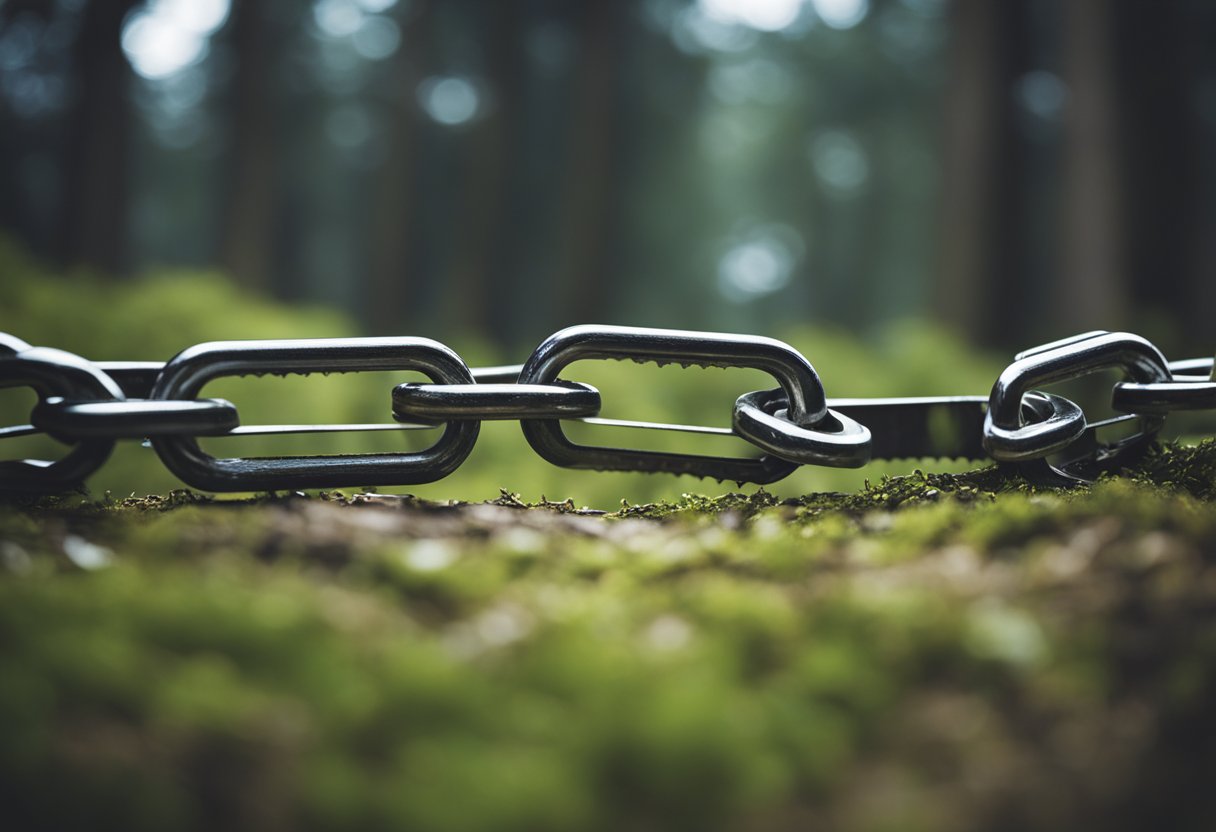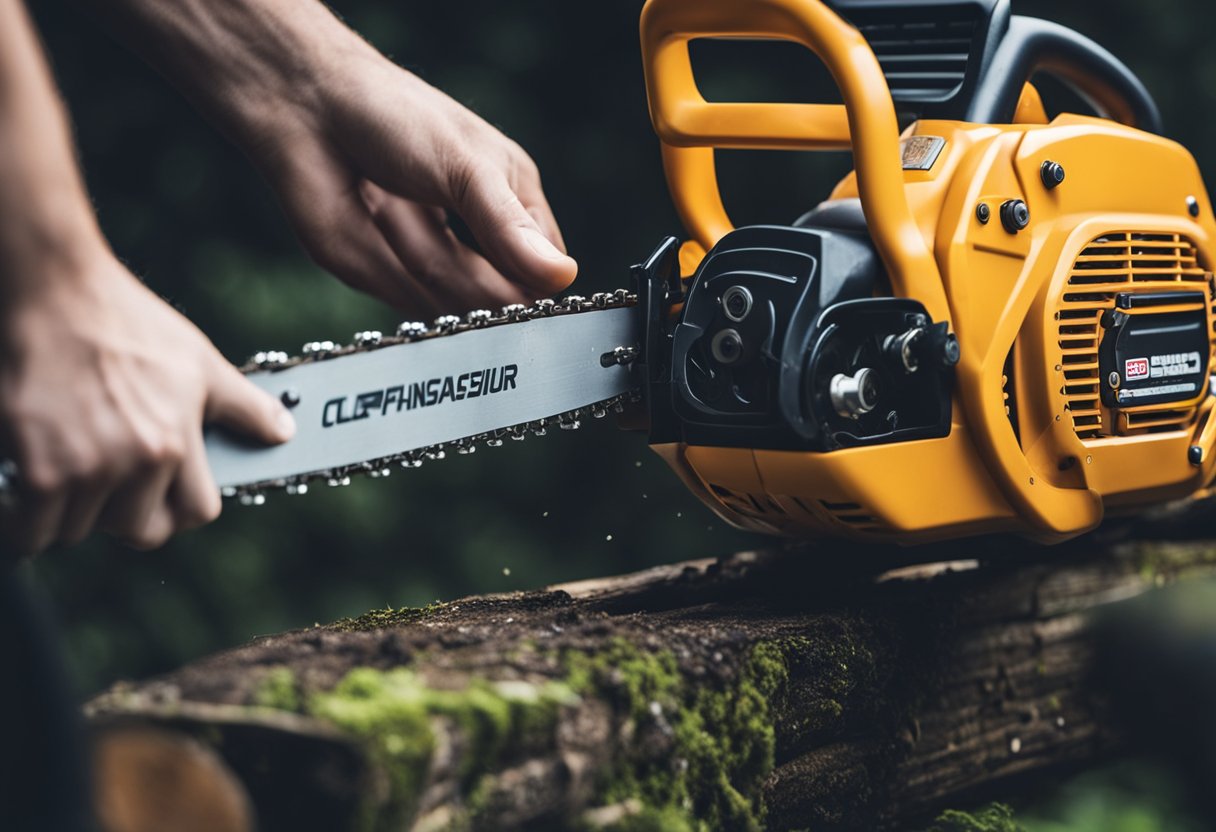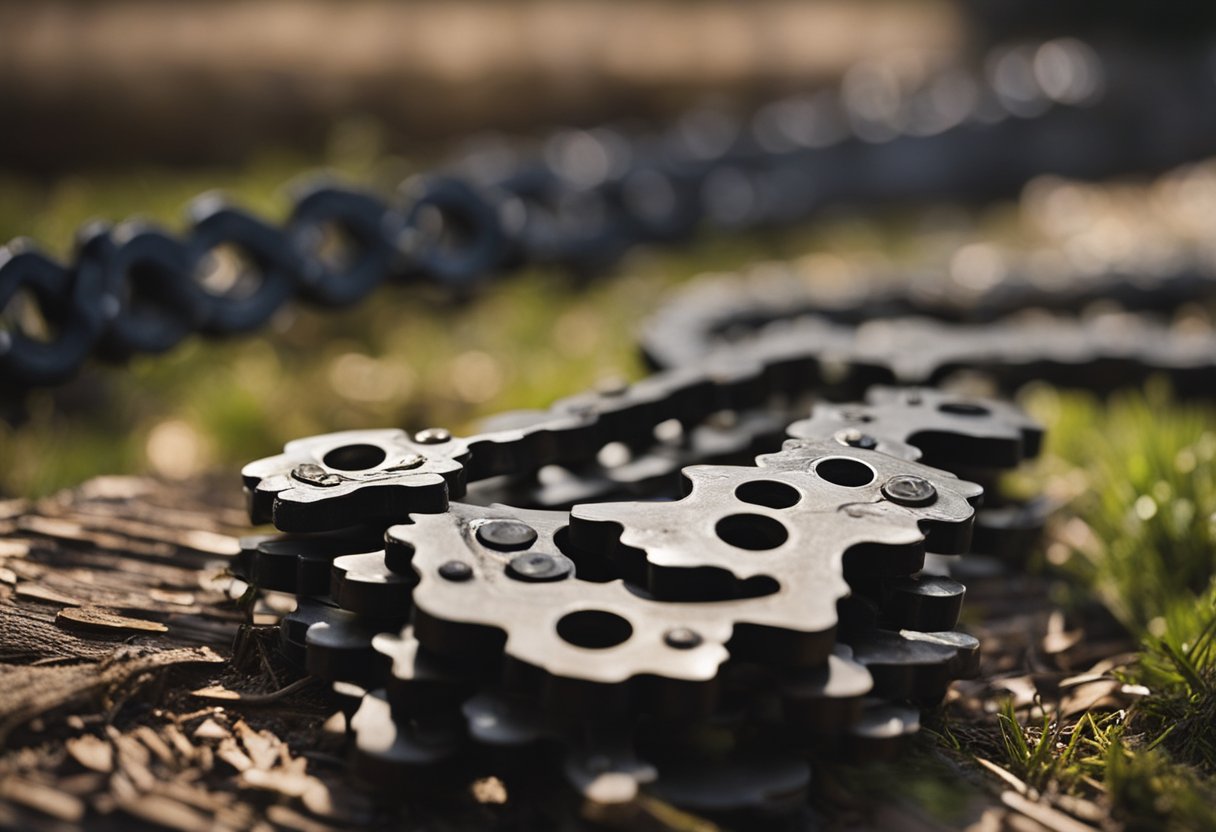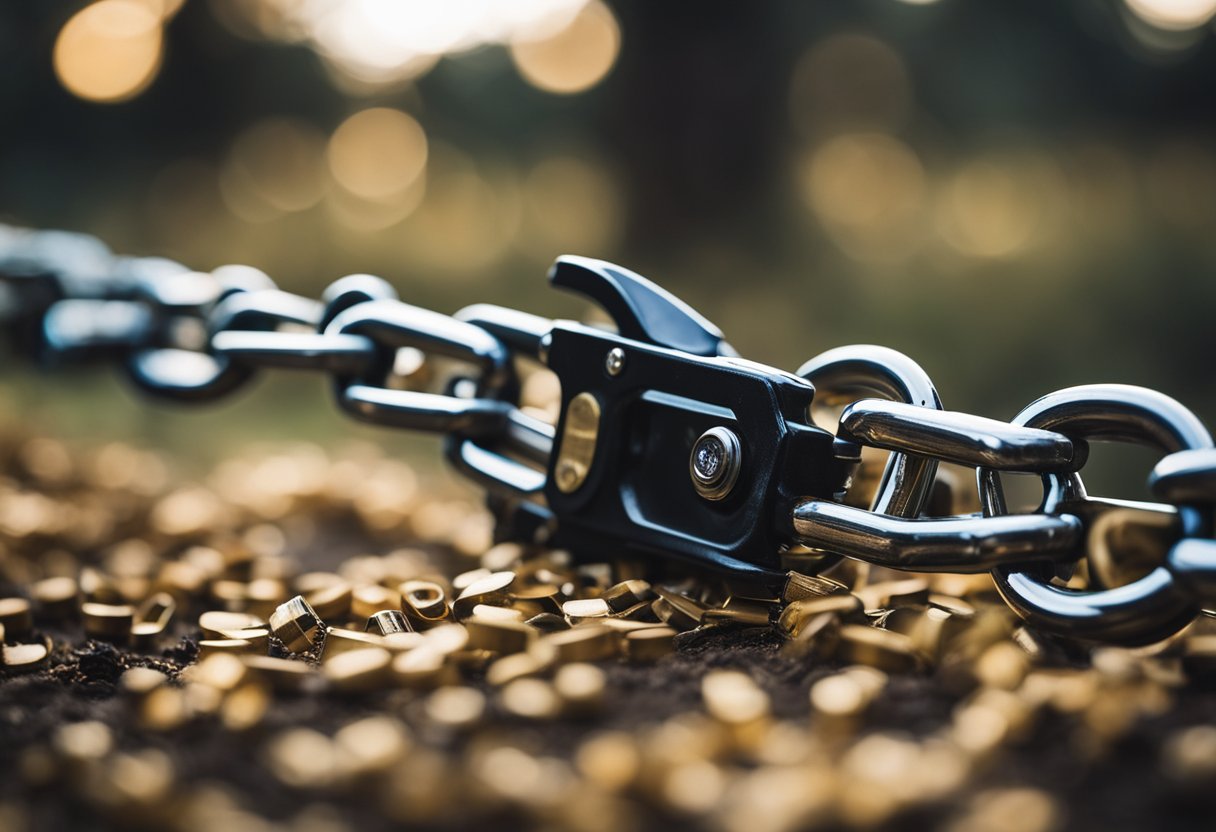I have been in situations where my chainsaw chain won’t tighten anymore, and I know how frustrating it can be. A chainsaw is a powerful tool that requires proper maintenance and care to work efficiently. One of the most common problems with chainsaws is the chain not tightening, which can be caused by several issues.
Understanding chainsaw chain tension is crucial to keeping your chainsaw working correctly. Incorrect tension can lead to the chain coming loose or breaking, which can be dangerous. Identifying common problems that can cause the chain not to tighten is the first step in fixing the issue. In this article, I will guide you through the process of tightening a chainsaw chain, including the tools required, maintenance and care tips, and safety measures to take while tightening the chain.
Key Takeaways
- Proper chainsaw chain tension is crucial for safe and efficient use of the tool.
- Common problems that cause chainsaw chains not to tighten include incorrect chain setting and temperature variation.
- To tighten a chainsaw chain, you need the right tools, proper maintenance, and safety measures.
Understanding Chainsaw Chain Tension
https://www.youtube.com/watch?v=FxgQSPQeYYM&embed=true
As a chainsaw owner, it’s important to understand the concept of chain tension. Chainsaw chain tension is the amount of slack or looseness in the chain when it is wrapped around the guide bar. Proper chain tension is vital for the chainsaw to function correctly and safely.
When a chainsaw chain is new, it may stretch after the first few uses, causing it to become loose. This is normal and expected. However, if the chain continues to stretch, it may indicate a problem with the chain or the chainsaw.
To tighten a chainsaw chain, you will need to locate the tensioning mechanism on your chainsaw. This may be a screw or a lever located near the guide bar. Turn the screw or adjust the lever until the chain is snug against the guide bar, but not too tight. Over-tightening the chain can cause damage to the chainsaw and can be dangerous.
It’s important to note that the correct tension for a chainsaw chain may vary depending on the make and model of your chainsaw. Consult your owner’s manual for specific instructions on how to tighten your chainsaw chain.
In addition to regular tightening, it’s important to inspect your chainsaw chain for signs of wear or damage. A damaged or worn chain can cause the chainsaw to malfunction or become dangerous to use. Look for signs of chain stretch, such as a loose chain that won’t tighten or a chain that slips off the guide bar during use.
By understanding chainsaw chain tension and how to properly tighten and inspect your chainsaw chain, you can ensure that your chainsaw is functioning correctly and safely.
Identifying Common Problems
https://www.youtube.com/watch?v=XAXjlYu1EFE&embed=true
If you’re experiencing issues with your chainsaw chain not tightening, there could be a few common problems that you’re facing. In this section, I will explain each of these problems in detail and provide you with some tips on how to identify them.
Loose Chains and Frequent Coming Loose
One of the most common problems with chainsaw chains is that they can become loose over time. This can happen for a number of reasons, including wear and tear, improper tensioning, or a stretched chain. A loose chain can cause a number of problems, including reduced cutting performance, increased risk of kickback, and even damage to the chainsaw itself.
To identify a loose chain, you can try gently pulling on the chain to see if it moves easily. If it does, then you may need to tighten the chain using the tensioning screw. If the chain keeps coming loose even after you’ve tightened it, then you may need to replace the chain altogether.
Wear and Tear of the Chainsaw Chain
Another common problem with chainsaw chains is wear and tear. Over time, the chain can become worn out, which can cause it to lose its sharpness and cutting performance. This can be caused by a number of factors, including frequent use, improper maintenance, and exposure to dirt and debris.
To identify a worn-out chain, you can look for signs of damage, such as missing or broken teeth, or excessive wear on the chain links. If you notice any of these signs, then you may need to replace the chain to ensure optimal performance.
Stretched Chain and Resistance
A stretched chain can also cause problems with your chainsaw chain not tightening. This can happen when the chain becomes worn out or when it is improperly tensioned. A stretched chain can cause the chain to become loose and can also cause increased resistance when cutting.
To identify a stretched chain, you can try pulling the chain taut and measuring the distance between the chain links. If the distance is greater than the manufacturer’s recommended length, then you may need to replace the chain. Additionally, if you notice increased resistance when cutting, then this may be a sign of a stretched chain.
In conclusion, there are a few common problems that can cause your chainsaw chain not to tighten properly. By identifying these problems and taking appropriate action, you can ensure that your chainsaw is working at optimal performance levels.
Guide to Chainsaw Chain Adjustment
https://www.youtube.com/watch?v=s4q6mxiOxXk&embed=true
As a chainsaw user, it’s essential to understand how to adjust the chainsaw chain. Adjusting the chainsaw chain is necessary for the proper functioning of your chainsaw. In this section, I will explain how to adjust your chainsaw chain using different methods.
Using the Chain Tensioner Screw
The chain tensioner screw is an essential component of the chainsaw. If your chainsaw chain won’t tighten, the tensioner screw could be the cause of the problem. To adjust the chainsaw chain using the tensioner screw, follow these steps:
- Locate the tensioner screw on your chainsaw. The tensioner screw is usually located on the side of the chainsaw, near the bar.
- Loosen the tensioner screw by turning it counterclockwise with a screwdriver.
- Adjust the tension of the chainsaw chain by pulling the bar away from the chainsaw body.
- Tighten the tensioner screw by turning it clockwise with a screwdriver until the chain is tightened.
Adjustment with Bar Nuts
Another method for adjusting the chainsaw chain is by using the bar nuts. The bar nuts are located on the side of the chainsaw, near the bar. To adjust the chainsaw chain using the bar nuts, follow these steps:
- Locate the bar nuts on your chainsaw.
- Loosen the bar nuts by turning them counterclockwise with a wrench.
- Adjust the tension of the chainsaw chain by pulling the bar away from the chainsaw body.
- Tighten the bar nuts by turning them clockwise with a wrench until the chain is tightened.
Tightening a New Chain
If you have a new chainsaw chain that won’t tighten, you may need to adjust it differently. To tighten a new chainsaw chain, follow these steps:
- Loosen the bar nuts by turning them counterclockwise with a wrench.
- Remove the chainsaw cover by unscrewing the screws that hold it in place.
- Remove the old chainsaw chain from the chainsaw.
- Install the new chainsaw chain on the chainsaw.
- Adjust the tension of the chainsaw chain by pulling the bar away from the chainsaw body.
- Tighten the bar nuts by turning them clockwise with a wrench until the chain is tightened.
- Replace the chainsaw cover by screwing the screws back into place.
In conclusion, adjusting your chainsaw chain is an essential part of chainsaw maintenance. By following the steps outlined in this guide, you can easily adjust your chainsaw chain using the tensioner screw, bar nuts, or when tightening a new chain.
Maintenance and Care for Chainsaw Chains
https://www.youtube.com/watch?v=D1T5qLra0wE&embed=true
As a chainsaw user, I know how important it is to maintain and care for your chainsaw chain. Proper maintenance and care can prevent many problems, including a chain that won’t tighten anymore. Here are some tips on how to properly maintain and care for your chainsaw chain.
Importance of Lubrication
One of the most important things you can do to maintain your chainsaw chain is to keep it lubricated. A well-lubricated chain will last longer and perform better than a dry chain. Make sure to use the right type of oil for your chainsaw and keep the oil reservoir filled. It is also important to check the oil flow regularly to ensure that the chain is getting enough lubrication.
Cleaning the Bar Groove
Another important aspect of chainsaw chain maintenance is cleaning the bar groove. The bar groove is where the chain rides on the guide bar, and it can become clogged with dirt, sawdust, and other debris. This can cause the chain to wear unevenly and eventually lead to a chain that won’t tighten anymore. To clean the bar groove, use a small brush or a specialized tool designed for this purpose.
Replacing Worn-Out Chain Sprocket
If your chainsaw chain won’t tighten anymore, it could be due to a worn-out chain sprocket. The chain sprocket is the small gear that the chain rides on, and it can wear out over time. If you notice that your chain is slipping or not moving smoothly, it may be time to replace the chain sprocket. This is a relatively simple task that can be done with a few basic tools.
By following these tips, you can keep your chainsaw chain in good condition and prevent problems like a chain that won’t tighten anymore. Regular maintenance and care are essential for the longevity and performance of your chainsaw chain.
Safety Measures While Tightening Chainsaw Chains
When working with a chainsaw, safety must always be a top priority. Tightening a chainsaw chain can be a dangerous situation if proper safety measures are not taken. Here are some safety measures that I always take when tightening a chainsaw chain:
-
Wear Protective Gear: Before tightening a chainsaw chain, make sure to wear protective gear such as safety glasses, gloves, and a helmet. This gear will help protect you from any flying debris or accidental cuts.
-
Engage the Chain Brake: Before tightening the chainsaw chain, make sure to engage the chain brake. This will prevent the chain from moving while you are working on it.
-
Use the Right Tools: Make sure to use the right tools to tighten the chainsaw chain. Using the wrong tools can cause damage to the chainsaw and can be dangerous.
-
Check the Tension: Before tightening the chainsaw chain, check the tension of the chain. A loose chain can cause kickback and a tight chain can cause damage to the chainsaw. Make sure to follow the manufacturer’s instructions for checking the tension.
-
Tighten Gradually: When tightening the chainsaw chain, tighten the chain gradually. Do not overtighten the chain as this can cause damage to the chainsaw and can be dangerous.
By following these safety measures, you can avoid dangerous situations while tightening a chainsaw chain. Always remember to prioritize safety when working with a chainsaw.
Tools Required for Chainsaw Chain Tightening
https://www.youtube.com/watch?v=Bu5bmJO2qKY&embed=true
When it comes to tightening a chainsaw chain, there are a few tools that you will need to have on hand. These tools will help you to make the necessary adjustments to the tension of your chainsaw chain, ensuring that it is working properly and safely.
Wrench
One of the most important tools that you will need is a wrench. This tool will allow you to loosen and tighten the nuts that hold the chainsaw bar in place. You will need to use the wrench to loosen the nuts before you can adjust the tension of the chain.
Scrench
Another tool that is commonly used for tightening a chainsaw chain is a scrench. This tool is a combination of a screwdriver and a wrench, making it a versatile tool that can be used for a variety of tasks. The scrench is often included with new chainsaws, but if you don’t have one, you can purchase one at a hardware store.
Adjustment Screw
The adjustment screw is the component that you will use to adjust the tension of the chainsaw chain. This screw is located on the chainsaw bar, and it is used to move the bar forward or backward, which in turn adjusts the tension of the chain. You will need to use your wrench or scrench to turn the adjustment screw.
Other Tools
In addition to the wrench, scrench, and adjustment screw, there are a few other tools that you may need to have on hand. These tools include pliers, a file, and a chainsaw sharpener. Pliers can be used to straighten any bent parts of the chainsaw, while a file can be used to sharpen the chain. A chainsaw sharpener is a specialized tool that can be used to sharpen the chain quickly and easily.
In conclusion, tightening a chainsaw chain requires a few tools, including a wrench, scrench, and adjustment screw. Having these tools on hand will allow you to make the necessary adjustments to the tension of your chainsaw chain, ensuring that it is working properly and safely.
Impact of Fuel and Dirty Wood on Chainsaw Chains
When a chainsaw chain won’t tighten anymore, it can be frustrating and dangerous. One of the reasons for this issue could be the fuel mixture. If the fuel mixture is incorrect, it can cause the chainsaw to bog down, which can lead to damage to the chain and other parts of the saw. To avoid this issue, it is essential to use the right fuel mixture. Most chainsaws require a mixture of gasoline and oil, and the ratio varies depending on the saw. It is essential to read the owner’s manual to get the right fuel mixture for your chainsaw.
Dirty wood can also cause a chainsaw chain to become loose. When the chain comes in contact with dirt, it can cause the chain to wear down faster, which can lead to the chain becoming loose. To avoid this issue, it is recommended to clean the wood before cutting it. If you are cutting a lot of dirty wood, it may be necessary to clean the chain more frequently.
In addition to the above, it is also important to use clean fuel in your chainsaw. Dirty fuel can cause the carburetor to become clogged, which can lead to the saw running poorly. This can cause the chain to become loose, as well as other issues. To avoid this issue, it is essential to use clean fuel and to store it properly.
Overall, it is important to take care of your chainsaw and its chain. By using the right fuel mixture, cleaning the wood, and using clean fuel, you can avoid issues like a chainsaw chain becoming loose. If you notice any damage to the chain or other parts of the saw, it is essential to get it repaired as soon as possible to avoid further damage.
Understanding the Role of Drive Links and Sprocket
When it comes to chainsaw chains, the drive links and sprocket play a crucial role in ensuring that the chain remains snug and in place during use. Drive links are the small, tooth-like components that fit into the sprocket, which is the wheel that rotates the chain around the guide bar. The drive links and sprocket work together to create the necessary friction and stress that keeps the chain tight and in place.
One of the most common reasons for a chainsaw chain not tightening anymore is a worn or damaged drive sprocket. Over time, the teeth on the sprocket can become worn down or damaged, which can cause the chain to slip and become loose. When this happens, it’s important to replace the drive sprocket as soon as possible to prevent further damage to the chain and guide bar.
Another factor that can affect the tightness of the chainsaw chain is the tension adjustment mechanism. If the tension is not set correctly, the chain may be too loose or too tight, which can cause it to slip or bind during use. It’s important to follow the manufacturer’s instructions for adjusting the tension, and to check the tension regularly to ensure that it remains snug.
In addition to the drive links and sprocket, the guide bar also plays an important role in keeping the chain tight and in place. The guide bar is the long, flat piece of metal that the chain wraps around, and it helps to guide the chain during use. If the guide bar is bent or damaged, it can cause the chain to become misaligned and loose. It’s important to inspect the guide bar regularly and replace it if necessary.
Overall, understanding the role of drive links and sprocket is essential for maintaining a tight and effective chainsaw chain. By keeping these components in good condition and adjusting the tension correctly, you can ensure that your chainsaw is always ready for use when you need it.
Frequently Asked Questions
How can I fix a chainsaw chain that won’t tighten?
If your chainsaw chain won’t tighten, there are a few things you can do to fix it. First, loosen the bar nuts and take off the clutch cover. Inspect the tensioning screw for any damage or signs of wear. Try to tension the screw while holding the clutch cover in your hand. If the screw doesn’t move or gets stuck, it means that the tensioner isn’t working properly. You may need to replace the tensioner or the entire clutch cover assembly.
What could be causing my chainsaw chain to come off repeatedly?
Several factors can cause a chainsaw chain to come off repeatedly, including a loose chain tension, worn-out bar or sprocket, or a damaged clutch. Additionally, if the chain is too loose, it can jump off the bar and cause damage to the chainsaw or the operator. Make sure to properly tighten the chain and inspect the bar, sprocket, and clutch for any signs of wear or damage.
What are common issues with Stihl quick chain adjusters?
Stihl quick chain adjusters are prone to failure due to their design. The adjuster consists of a small plastic wheel that can wear out quickly and cause the chain to loosen or come off. Additionally, the adjuster can become clogged with debris, preventing proper tensioning of the chain. If you are experiencing issues with your Stihl quick chain adjuster, consider replacing it with a more durable aftermarket adjuster.
Why does my Craftsman electric chainsaw chain keep coming off?
A loose chain tension is the most common cause of a Craftsman electric chainsaw chain coming off. Make sure to properly tighten the chain and inspect the bar, sprocket, and clutch for any signs of wear or damage. Additionally, make sure that the chain is the correct size for the bar and that it is properly lubricated.
How do I properly tighten a chainsaw chain?
To properly tighten a chainsaw chain, first, loosen the bar nuts and take off the clutch cover. Then, use the tensioning screw to adjust the tension of the chain. Make sure to properly tension the chain, so it is snug against the bar but still moves freely. Once you have properly tensioned the chain, tighten the bar nuts and reattach the clutch cover.
What are common reasons for a chainsaw chain to become loose?
A chainsaw chain can become loose due to a variety of reasons, including a worn-out bar or sprocket, a damaged clutch, or a loose chain tension. Additionally, if the chain is too loose, it can jump off the bar and cause damage to the chainsaw or the operator. Make sure to properly tighten the chain and inspect the bar, sprocket, and clutch for any signs of wear or damage.

Hi, I’m Sal Muller of Tooltrip.com. My DIY experience led me to understand essential power tools for home projects. Tooltrip.com guides enthusiasts and professionals in choosing right tools for any job. I provide concise top tool reviews for easier, efficient DIY.






